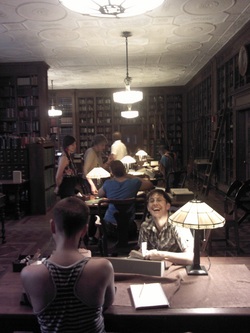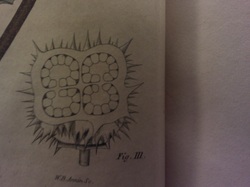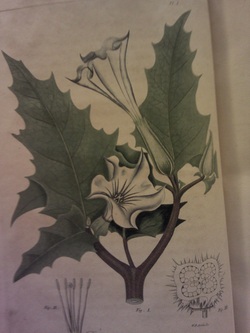


| Stephen Rye Switzer, L.M.T. Massage and Herbal Medicine |
|
 I'm helping to facilitate a class - Level II herbal studies - with Jacoby of Third Root Community Health Center (where I spend a lot of my time). We took a field trip to the rare book room of the New York Academy of Medicine yesterday to look at herbals from the 15th Century to now. The librarian had set out crumbling texts that were held together with ribbon, that we carefully turned the pages of looking up our favorite plants. I spent a lot of time looking at early-American texts by Samuel Thompson, an early 19th century self-taught herbalist in the Northeast. His favorite plants were by far, lobelia and cayenne. They came first in his materia medica and had pages upon pages of uses.  Datura also kept coming up in my browsing. You can find this plant growing in tree-pits around brooklyn this time of year - wild (or scattered by a moder-day Johnny-Datura?) and growing furiously in late summer. Many a night I've been out late and observed a few datura growing on my walk home through Clinton Hill. The seedpods are spikey and noticable -> and quite beautiful in this drawing.  Datura, or Thorn Apple, is a notorious hallucinogen & dangerous. It's beautiful and the flowers open at night (why you see it in the late evening walking home) and has been co-evolving with humans for hundreds of years. Would I recomend you taking some? No - not unless you go to the rare book room at NYAM and read all the texts about this beautiful plant. The early American herbalists and botanists have a lot to say. I'm excited to say hello to this plant on the street - but will still stay my distance from ingesting it even after reading the herbals from 100 years ago.
1 Comment
I am the proud caretaker of the herb garden at the Tivoli housing co-op in upstate New York. And by caretaker, I mean I'm just following the plan of the previous gardener, getting starting on planting and clearing space for cultivated herbs these last few warm weeks of Sprin-winter. There are many medicinal plants growing in the "way" of the garden, but the one I was digging up last week first was Yellow Dock. One of my most powerful experiences with herbs involved a 1 week liver detox that included yellow dock, oregon grape, dandelion, and yes, yellow dock. A common field weed, yellow dock is a superior reliever of liver stagnation and deficiency. I had had a rough winter, and the yellow dock helped to jump-start my body and mind - relieving past bad habits and creating space for new habits of health and lightness. Yellow dock is nutritive and gets things moving, resolving dampness and stagnation in a deficient Spleen/Stomach and Liver/Galbladder meridians. Yellow dock is also a remedy for nettle stings - and often grows close by - but only if you sing the tune "Nettle in, dock out. Dock rub nettle out!"
I've noticed dandelion, burdock, violet and other old friends sprouting up all over the place. Nettles are next, ramps, and the elderflowers! Be in touch if you'd like to talk more about liver detoxing - I'm starting my annual one in a week or so and would love to do it with you. |
AuthorStephen Rye is a massage therapist, herbalist, gardener, and organizer. Archives
August 2016
Categories
All
|